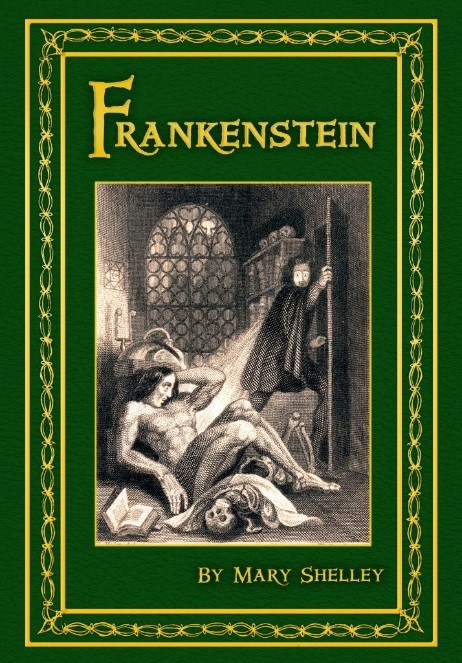
Mary Shelley’s Frankenstein is a three-volume gothic novel with elements of horror and science fiction. It narrates the tale of Victor Frankenstein, who creates and animates a human being referred to as the Creature, then has to deal with the consequences.
The first volume introduces the epistolary frame of the novel, as well as the explorer Robert Walton who has taken an interest in the doctor and recounts Frankenstein’s tale to his sister. Frankenstein narrates his youth for Walton, including his first experience with death and the many other experiences that led up to the manufacturing of his own human being. Despite his initial glorification of the idea, Frankenstein is horrified upon the Creature’s awakening, particularly distraught by its ugly appearance. Despite trying to forget about the horrid monster completely, the Creature manages to find him once again and addresses Frankenstein’s responsibility as his creator. Frankenstein, torn between his morals and his desire to no longer be associated with the Creature, begrudgingly agrees to his requests, but changes his mind and follows his morals, deciding to destroy this burden once and for all. But, is it too late?
Though the story takes place in the eighteenth century, it was written in the nineteenth, when ideas such as galvanism were fresh in the minds of the population. The horror of this novel was accentuated by the fact that this story seemed completely realistic to the audience of the time. But, centuries of research and study have since disproved the ideas that provided a scientific basis for Frankenstein.
Though I am aware that Frankenstein’s creation of a human being is impossible, it is still scary how realistic the Creature was. In the Creature’s first-person narrative, he describes his process of observing humans, empathizing with them, and learning how to read in an attempt to befriend them. He learns how to speak and write using books and listening to human conversations, so the way he talks is similar to Frankenstein; this makes it difficult to remember that he was not created naturally. Shelley’s characterization of the Creature raises the question of who is more human: the Creature or the creator?
Compassion for the monstrous Creature is not the only compelling issue that Shelley explores. The novel offers a possible scenario of science going too far and emphasizes the role of morals in science. Frankenstein’s motivations for his scientific ambition are questionable, but he continuously glorifies the act of creation, emphasizing the innovative possibilities. It was almost poetic when he saw his beautiful, perfectly-crafted Creature come to life and all of his ambitions and motivations transform into regret and anxiety. I also thought the emphasis on external appearance and the concept of “beauty” vs. ugly intriguing. Shelley hints at the topic when describing Frankenstein’s youth and directly contrasting his reaction and behavior towards two professors, but it emerges fully when Frankenstein’s initial reaction to the Creature is, to be frank: it’s so ugly. He is not alone in that sentiment, though, as virtually everyone that the Creature encounters is shocked by his ugly appearance. Considering how human the Creature is, this can be compared to real life responses to people with visible differences and how these responses can impact them. Although I do not think it was the appropriate response, I was able to sympathize with the Creature’s anger because of how much rejection he had faced merely due to his visage. I really enjoyed the themes that Shelley interwove into Frankenstein, as their application to life today makes it a truly timeless novel.
Shelley writes using language and grammatical structures common to her time, but archaic to ours. It takes some effort to adapt to this difference in dialect, but Frankenstein’s use of words such as “wretch” and “daemon” (which does have a different meaning than the word demon) emphasize his feelings of disgust towards the Creature.
Overall, I would give this novel an 8/10. It was a little unsatisfying, since I always felt like I was missing something due to the nuances of language. But, it was still pretty good. I am not someone who usually enjoys horror novels, so it was reassuring to know that there was no one Frankenstein’s procedures would work in real life. Yet, I was still able to experience fear and suspense due to the themes that Shelley explores that still apply to life today. Frankenstein is a classic that can be enjoyed by all, but I would recommend it especially to those interested in science fiction or science in general.
Check out Frankenstein at the Newport Beach Public Library.
